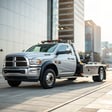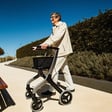Falls at home present serious risks for older adults, especially in bathrooms where wet surfaces create hazards.
Understanding the Need for Bathroom Safety Bars
The statistics tell a sobering story. According to the National Council on Aging, more than 75% of older adult falls happen in or near the home, with bathrooms being particularly dangerous zones. The combination of water, smooth surfaces, and the physical movements required during bathing creates a perfect storm for potential accidents.
Mary, my neighbor who recently turned 78, told me last Tuesday about her close call. "I almost went down reaching for my shampoo," she said. "That's when my daughter insisted on installing those grip bars. I was resistant at first—thought they'd make my bathroom look like a hospital—but now I wouldn't be without them."
Her experience isn't unique. Many seniors initially resist bathroom modifications, seeing them as acknowledgments of declining independence. But properly installed safety features actually promote autonomy by preventing injuries that could lead to loss of independence.
Best Shower Bars for Seniors: Options and Features
When shopping for shower grip bars, you'll find several types designed for different needs and bathroom configurations:
Wall-mounted grab bars offer the most stability when properly installed into wall studs. These permanent fixtures typically support between 250-500 pounds when installed correctly. Look for ADA-compliant models with textured surfaces for better grip when wet.
Suction cup bars provide temporary support without requiring installation. While convenient, they're generally not recommended as primary safety devices for elderly users because their holding power can diminish over time. These might work for travel situations but aren't ideal for daily home use.
Clamp-on tub rails attach to the side of the bathtub, providing support when entering or exiting. The Amazon-listed "Bath Tub Handles for Seniors" features this design with a clamp mechanism that requires no drilling.
Corner shower bars utilize two walls for additional stability, creating an L-shape that helps with balance during position changes.
When selecting bathroom safety bars, consider:
- Weight capacity (look for at least 250 pounds)
- Grip diameter (1.25-1.5 inches works best for most hands)
- Texture (non-slip surfaces enhance safety)
- Contrast color (bars that visually stand out from walls help with visibility)
The National Institute on Aging specifically recommends grab bars in contrasting colors, which is particularly important for seniors with vision impairments or cognitive conditions like Alzheimer's.
Strategic Placement of Non-Slip Shower Handles
The effectiveness of shower grip bars depends significantly on their placement. Based on recommendations from occupational therapists and safety experts, here's where to install them:
- Entry point to shower or tub (vertical bar)
- Inside shower at standing height (horizontal bar)
- Near shower controls (vertical or diagonal bar)
- Toilet area (horizontal bar on side wall)
I've found that many people overlook the importance of that first vertical bar at the entry point. It's crucial for that precarious moment of stepping over the tub edge when balance is most compromised.
According to 2nd Family, a senior care organization, "Strategic placement of grab bars, routine maintenance, and awareness of cost considerations, including potential financial assistance programs, are essential aspects of bathroom safety planning." This holistic approach ensures that safety modifications serve their intended purpose effectively.
Elder Care Bathroom Modifications: Beyond Grab Bars
While shower grip bars form the foundation of bathroom safety, a comprehensive approach includes several additional modifications:
- Non-slip mats both inside and outside the shower
- Shower seats or benches for seated bathing
- Handheld showerheads with easy-to-reach controls
- Raised toilet seats (often with integrated grab bars)
- Adequate lighting to eliminate shadows
- Medical alert systems with bathroom help buttons
ElderLife Financial Services notes that many raised toilet seats come with built-in grab bars, providing additional stability during transfers. They also recommend installing medical alert system buttons in bathrooms as a backup safety measure.
These modifications work together to create a comprehensive safety system. For instance, non-slip mats reduce fall risk, while grab bars provide recovery points if slipping occurs. The shower seat eliminates the need to maintain standing balance throughout bathing.
How Much Do Quality Bathroom Safety Bars Cost?
The investment in bathroom safety varies widely based on product quality and installation requirements:
- Basic wall-mounted grab bars: $20-$50 each
- Designer grab bars with decorative finishes: $50-$150 each
- Professional installation: $100-$300 depending on bathroom configuration
- Complete bathroom safety packages: $500-$2,000
While this might seem expensive, compare it to the average cost of a fall-related hospitalization—approximately $30,000 according to CDC data—and the investment becomes clearly worthwhile.
Some Medicare Advantage plans cover bathroom safety modifications, and organizations like Area Agencies on Aging sometimes offer financial assistance programs. Veterans may qualify for home modification grants through the VA.
DIY vs. Professional Installation: What's Safest?
Can you install shower grip bars yourself? Possibly, but I'm hesitant to recommend it.
The critical factor is securing the bar to wall studs or using appropriate anchoring systems for tile or fiberglass surrounds. Improper installation creates a false sense of security with potentially dangerous consequences.
If you're comfortable with home improvement projects and have the right tools, including a stud finder, you might tackle this project. However, the stakes are high if installation fails. I'd suggest at least consulting with a professional who specializes in aging-in-place modifications before proceeding.
How do I choose the right shower grip bars for an elderly family member?
This question comes up frequently, and the answer depends on several factors:
First, consider your loved one's specific needs. Do they have particular strength limitations or balance issues? Someone recovering from hip surgery has different requirements than someone with general age-related balance concerns.
Second, evaluate the bathroom's construction. Older homes might need reinforcement before installation, while newer construction generally accommodates standard mounting hardware.
Third, think about aesthetics and dignity. Today's bathroom safety bars come in stylish designs that complement bathroom décor rather than creating an institutional appearance. Brands like Moen and Delta offer designer grab bars that look like towel bars but provide safety-rated support.
Finally, consult an occupational therapist if possible. These professionals can assess specific needs and recommend personalized solutions that address individual mobility challenges.
Disclaimer: This content is for informational purposes only and not financial advice. Consult with healthcare professionals, occupational therapists, and financial advisors before making decisions about home modifications. Tax benefits and insurance coverage for home safety modifications vary by jurisdiction and individual circumstances.
Tags

About Claudia Yates the Author
Claudia Yates is a seasoned financial analyst and author, specializing in tackling complex financial challenges faced by emerging businesses. With over 15 years of industry experience, she excels at creating innovative strategies for financial growth and stability.
Recommended Articles
How to Detect Macular Degeneration Early
Learn to detect macular degeneration early through eye exams and understanding symptoms, ensuring proactive eye health management.
Rent-to-Own Tow Trucks: What to Know in 2026
Explore rent-to-own tow trucks in 2026, offering flexibility for operators to gradually gain ownership while managing costs effectively.
How to Spot a Valuable Toy Before Selling It at a Garage Sale
Learn how to identify valuable toys to sell at garage sales, maximizing profit while decluttering your home. Find out what buyers are looking for!
5 Old Household Items That Are Suddenly Worth Money
Discover five old household items that could be worth a lot of money today, from vintage typewriters to collectible toys and more.
The Smart Rollator That’s Redefining Independence for Seniors
Smart rollators are revolutionizing senior mobility by integrating advanced technology, such as intelligent braking systems, GPS for location tracking, and health monitoring features, which improve safety and reduce healthcare costs through fall prevention. These devices, despite their higher upfront cost, offer long-term financial benefits by delaying the need for costly home care, and some insurance plans may cover the associated expenses.




